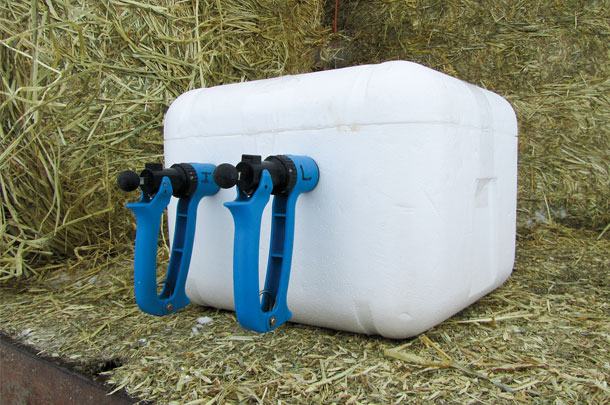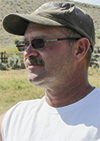With the mercury gathered in the bottom of the thermometer for days on end, and the snow piling up, we had cause to reminisce about past winter experiences at the chute: our first years of giving pre-calving vaccine in the winter – cussing the vaccine freezing in the needles – unaware that an issue larger than this inconvenient situation lurked unseen to the naked eye.
By exposing the vaccines to these freezing temperatures, we were compromising the level of immunity we were trying to give the cows.
Today, most producers understand that vaccine is inherently fragile and has a small window of temperature tolerance and low resistance to ultraviolet light from the sun. As damage occurs, efficacy is compromised.
There are several factors involved in the effective immunization of an animal: general health, body condition, weather conditions, injection techniques and the quality of the vaccine – to name a few.
Research and storage
Through our BQA programs, we have learned the proper methods for injecting vaccine. The results of studies begun in 2009 in Arkansas and Idaho are helping producers learn the importance that our methods of storing and handling vaccine play on potency and quality – all the way from the seller of the vaccine to the cow.
In 2009, these studies began with participating retailers and producers placing LogTag data loggers in their vaccine storage refrigerators. Initial temperature data collected from participating retailers’ vaccine coolers across the state of Idaho demonstrated that a substantial number of these coolers did not maintain the recommended 35ºF to 45ºF temperature band for safe storage of vaccine.
Only 34 percent of retailers’ vaccine coolers tested during the Idaho study stayed within the 35ºF to 45ºF range 95 percent of the 48-hour collection period.
Shannon Williams, University of Idaho Extension educator for Lemhi County, one of a group of extension educators participating in the studies, says, “We placed the data loggers in the retailers’ and producers’ refrigerators and asked that they fill out a survey answering questions regarding their storage and handling procedures.
We collected a minimum of 48 hours’ data from each participant and downloaded this information into spreadsheets for analysis. From the data we collected from the LogTag data loggers, and the surveys, we encourage producers to ask retailers if they monitor temperature and record it regularly.”
In addition to testing the temperature of retailers’ vaccine refrigerators, participants tested individual producers’ vaccine refrigerators across the state. “Of the participating producers’ refrigerators tested for the study, 67 percent failed to maintain the proper temperature required by the vaccine manufacturers,” says Williams. “We anticipated finding the most failure in the really old refrigerators out in the producers’ garage.
Surprisingly, we found more failures in newer refrigerators that were installed in locations with surrounding air temperature ranges outside of the manufacturers’ recommendations. One producer’s refrigerator performed perfectly for three days in the garage – until the outside temperature dropped to -10 degrees, and then the internal temperature dropped well below the recommended 35-degree minimum required for vaccine.”
Gauging temperatures
Bruce Mulkey, owner of Mulkey Ranch located near Baker, Idaho, participated in the study and says, “The refrigerator in our house was one of the best tested in the area, but the new refrigerator we put in Mom’s old house (not currently occupied) would not regulate until I put a small heater by it that kicked on when the house got below a set temperature.”
Williams recommends that producers place thermometers in these refrigerators and monitor the temperature on a regular basis. “In instances where you anticipate storing large quantities of expensive vaccine, use a thermometer that allows you to pre-set a safe band, sounding an audible alarm if the temperature rises or falls outside of that band.”
Armed with this data, Williams and other participants became curious about the conditions vaccine was exposed to between the refrigerator and the cow. Producers participating placed thermometers in the coolers they were using to transport vaccine from the retailer to home and from the refrigerator to the chute.
The findings revealed that heavier solid-sided coolers were more effective and soft-sided coolers the least reliable.
Discovering how much temperature variation was occurring within the coolers during the tests, several participating producers began to experiment with methods to protect the vaccine beyond the bottle in the cooler.
Understanding the risks to the vaccine and realizing that a vaccine gun may be idle for a period of time between uses, these producers cut holes in coolers to make it easy to insert the gun into the cooler without taking the lid off and on.
 Mulkey says, “My vaccine comes in a nice heavy Styrofoam cooler when I get it from my supplier. I use a sharp knife to cut the holes for the vaccine guns, but some guys – using hard-sided coolers – are using wood drill bits.
Mulkey says, “My vaccine comes in a nice heavy Styrofoam cooler when I get it from my supplier. I use a sharp knife to cut the holes for the vaccine guns, but some guys – using hard-sided coolers – are using wood drill bits.
I put my holes in the lid but have a little trouble with the needles wanting to stick in the cold packs. I think I will put them in the top of one side on the next one.”
Here at home, through experiences such as the recent round of cold-weather pre-calving vaccinations, we have learned to keep the vaccine in a cooler separate from the vaccine guns and monitor the temperature with a digital thermometer attached to the inside wall of the cooler – above the cold/hot source with double-sided tape.
We use coolers modified much like the one described by Mulkey and monitor the temperature in the coolers with the same system that we use with the vaccine coolers.
Other key suggestions
During the recent cold weather event, we implemented Williams’ recommendation for keeping vaccine, and the guns, warm enough on cold days. She gives the basic recommendation for cold weather as follows:
- Outside temperature of 36ºF – no cold/hot source needed.
- Outside temperature of 29ºF – 2 cups hot tap water in a glass canning jar will maintain a medium-sized cooler within the acceptable temperature range for 4.5 hours.
- Outside temperature of 13ºF – 2 cups hot tap water in a glass canning jar will maintain a medium-sized cooler within the acceptable temperature range for three hours.
Controlling the temperature of vaccine from the retailer to the cow will prove to be an ongoing challenge for producers, but Williams suggests that if producers are diligent in pursuing a few precautionary steps, damage to vaccine caused by unacceptable temperature conditions and ultraviolet light can be minimized.
The following is a guideline to aid you in developing a good storage and handling protocol for your cattle vaccine:
- Ask your retailer about temperature monitoring.
- Take your own cooler with cold/hot packs and a thermometer to pick up your vaccine from a retailer, add or subtract cold/hot packs as needed to regulate the temperature.
- When ordering vaccine, place orders on a Monday to ensure the vaccine does not sit on a loading dock over a weekend. When this vaccine arrives, make sure the cold packs are still cold and the vaccine is not frozen. If you are concerned about the condition of the vaccine, contact the distributor immediately.
- Monitor the temperature in your vaccine storage refrigerator.
- Preheat or cool your coolers for a least an hour before filling with vaccine.
- Don’t put all of the vaccine for a big day in the cooler at once. Only pack the vaccine needed for the morning or the afternoon.
- Protect your vaccine in coolers with the appropriate cold/hot packs; use a thermometer to monitor the temperature. Take extra packs to add later. Keep coolers out of direct sunlight on hot days.
- Protect the vaccine in your guns from temperature and sunlight by placing in a cooler with adequate cold/hot packs when not actively in use.
- Don’t place vaccine directly on hot/cold sources in the cooler. Cold packs are most effective when placed vertically against the sides of the cooler versus flat on the bottom.
- Discard any vaccine that has frozen or been exposed to hot or cold temperatures outside of the manufacturers’ recommendation for any extended period of time.

PHOTO 1: Author administering pre-calving vaccine in winter.
PHOTO 2: Author’s cooler for protecting vaccine in guns. Note the placement on side of cooler, so as not to interfere with cold/hot packs. Photos provided by Michael Thomas.

-
Michael J. Thomas
- Freelance Writer
- Salmon, Idaho
- Email Michael J. Thomas







